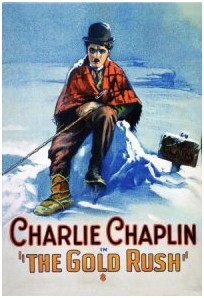

The Gold Rush is a 1925 silent film comedy written, produced, directed by, and starring Charlie Chaplin in his Little Tramp role. The film also stars Georgia Hale, Mack Swain, Tom Murray, Henry Bergman, and Malcolm Waite.
Chaplin declared several times that this was the film that he most wanted to be remembered for.
Though a silent film, it received an Academy Awards nomination for Best Sound Recording.
Plot
The Tramp (Charlie Chaplin) travels to the Yukon to take part in the Klondike Gold Rush. Bad weather strands him in a remote cabin with Big Jim, a prospector who has found a large gold deposit (Mack Swain) and Black Larsen, an escaped fugitive (Tom Murray), after which they part ways, with Big Jim and Black Larsen fighting over the prospector's claim, ending with Big Jim receiving a blow to the head and Black Larsen falling off a cliff to his death. The Tramp eventually finds himself in a gold rush town where he ultimately decides to give up prospecting.
After taking a job looking after another prospector's cabin, he falls in love with a lonely saloon girl (Georgia Hale) whom he mistakenly thinks has fallen in love with him. He soon finds himself waylaid by Big Jim, who has developed amnesia and needs the Tramp to help him find his claim by leading him back to the first cabin.
One sequence was altered in the 1942 re-release so that instead of the Tramp finding a note from Georgia which he mistakenly believes is for him, he actually receives the note from her. Another major alteration is the ending, in which the now-wealthy Tramp originally gave Georgia a lingering kiss on board ship; the sound version ends before this scene. Now, the two share a romantic moment by the old house.
Critical reception
In its original 1925 release, The Gold Rush was generally praised by critics. Mordaunt Hall wrote in The New York Times:
Here is a comedy with streaks of poetry, pathos, tenderness, linked with brusqueness and boisterousness. It is the outstanding gem of all Chaplin's pictures, as it has more thought and originality than even such masterpieces of mirth as The Kid and Shoulder Arms.
At the 1958 Brussels World Fair, critics rated it the second greatest film in history, behind only Eisenstein's The Battleship Potemkin. In 1992 The Gold Rush was selected for preservation in the United States National Film Registry by the Library of Congress as being "culturally, historically, or aesthetically significant".
Background
Lita Grey was originally cast as the leading lady. Chaplin married Grey in mid-1924, and she was replaced in the film by Georgia Hale. Although photographs of Grey exist in the role, documentaries such as Unknown Chaplin and Chaplin Today: The Gold Rush do not contain any film footage of her, indicating no such footage survives.
Chaplin attempted to film many of the scenes on location near Truckee, California, in early 1924. He abandoned most of this footage (which included him being chased through the snow by Big Jim, instead of just around the hut as in the final cut), retaining only the film's opening scene. The final film was shot on the backlot and stages at Chaplin's Hollywood studio, where elaborate Klondike sets were constructed.
Discussing the making of the film in the documentary series Unknown Chaplin, Hale revealed that she had idolized Chaplin since childhood and that the final scene of the original version, in which the two kiss, reflected the state of their relationship by that time (Chaplin's marriage to Lita Grey having collapsed during production of the film). Hale discusses her relationship with Chaplin in her memoir Charlie Chaplin: Intimate Close-Ups.
The Gold Rush was a huge success in the US and worldwide. It is the fifth highest grossing silent film in cinema history, taking in more than $4,250,001 at the box office in 1926, and the highest grossing silent comedy. Chaplin proclaimed at the time of its release that this was the film for which he wanted to be remembered.
1942 re-release
In 1942, Chaplin released a new version of The Gold Rush, taking the original silent 1925 film and composing and recording a musical score, adding a narration which he recorded himself, and tightening the editing which reduced the film's running time by several minutes. The film is also shortened by being run at 'sound speed', i.e. 24 frames per second; like most silent movies it was originally shot and exhibited at a slower speed. As noted above, Chaplin also changed some plot points. Besides removing the kiss at the end, another change eliminated a subplot in which Charlie is tricked into believing Georgia is in love with him by Georgia's paramour, Jack.
The new music score by Max Terr and the sound recording by James L. Fields were nominated for Academy Awards in 1943.
The Gold Rush was the first of Chaplin's classic silents that he converted to a sound version in this fashion.[3] As revealed in the 2003 DVD release, the reissue of The Gold Rush also served to preserve most of the footage from the original film, as even the DVD-restored print of the 1925 original shows noticeable degradation of image and missing frames, artifacts not in evidence in the 1942 version.



















